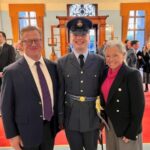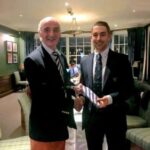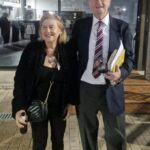We are always delighted to hear from OHs. Recently, Malcolm Innes (Ha 53) contacted us about some dramatic events in India during the final months of the Second World War. As Malcolm explains, he witnessed three miracles in one that day as a twin-engined Lockheed Lightning suddenly came hurtling down the runway towards him. We print his letter in full – whose memories of that day are bright and vivid…
My father was a scholar to Haileybury (Hailey) and Head of School. He spent his whole life working in India and was awarded the KBE and knighted by the Queen in her first investiture after her coronation. I had two uncles also in Hailey one of whom, M.C.Innes, was killed in the war; my brother was also in Hailey, and lastly so was I from 1952 to 1957.
I now live in a retirement complex in Spain and wrote an article for the complex’s magazine which I thought might be of interest to you as it mentions India and gives an idea of the life that many ex-patriots shared while overseas during the war. I also wrote an article on Douglas Cook (“Killer” Cook) which was published in the Haileybury 150th anniversary book (now out of print – ed.)
The story which follows is autobiographical so I can vouch for its veracity!
A true story of a very lucky escape
My elder brother started at his boarding school in England when he was eight and my mother and sister sailed for Calcutta, India in 1938 where my father worked for a very large English Company. I was born in 1939 just before the outbreak of The War. We were not able to return home ( as all ex-patriots called Britain) until 1946, so I first met my brother. When he was 15 and I was 7. We lived in a house on the outskirts of Calcutta in a district called Alipore.

(Above: some of the airmen and ground staff at Alipore, with a Hawker Hurricane behind. The man leaning on the exhaust manifold of the Hurricane is identified as Jimmy Graham, who became a firm friend of the family, visiting often at Alipore – image: M. Innes)
Nearby was a small local aerodrome also called Alipore. Apart from the war in Burma and the Malaysian peninsula there was not much activity except for the occasional Japanese bombing raid.

(Above: A Lockheed Lightning being serviced at Chittagong, a sight which would have been familiar to Malcolm)
After VE Day attention started to turn to the Far East and some RAF planes started to arrive and were based at Alipore. My mother volunteered to go round the aerodrome every morning in a small white van with a young Indian driver with supplies of hot coffee, tea and cocoa and biscuits. She took my sister with her and I would sit on her lap. We would visit each plane which was parked under the trees for shade and so as not to be visible to Japanese planes taking photographs, and the aircrew would appear with mugs ready for their drinks.

(Above: the unusual twin-engined Lockheed Lightning , here in US colours; the subject of this article)
All clear to cross the runway…
We had to cross the runway near the far end which was being extended with piles of rubble and hundreds of workmen everywhere. At the point for crossing there was a sentry box with an Indian man inside reading a newspaper. He would look towards the control tower a few hundred yards away and if the light was showing green he would wave us across. On that particular morning all was going as normal and our van started to chug across the runway when suddenly a siren sounded and we looked towards the control tower. A red light was flashing and our driver alarmed by all the confusion stalled the engine.
But suddenly…
Now our little white van had a starter motor which never worked and it always had to be started using the crank handle. Looking down the runway we suddenly saw an American fighter plane called a Lightning swoop over the trees and come straight on to the runway with no undercarriage. It therefore had no brakes and no way of steering and was coming straight for us.
The driver was reluctant to get out to crank the engine, but pressed the starter button. Amazingly the engine started and we began to jerk backwards from our position nearly half way across the runway. Meanwhile the Lightning was coming towards at over a hundred miles an hour.
Running to get away!
In an instant the plane flashed by us with its wing missing our bonnet by a few feet. It then ploughed into where the runway was being extended. The workmen having heard the siren had all dropped the baskets of brick and rubble they had on their heads and were running to get away.
The Lightning was notorious for exploding, but as the plane stopped in a huge cloud of red dust, the pilot threw back the canopy which covered the cockpit, jumped on to the wing, ran along it and jumped off and dived into the nearest hollow he could find. We all waited for the explosion, but in the silence that followed we suddenly heard the bell of the fire engine which was rung by the driver’s passenger with his hand out of the window.

(Above: a crashed Lockheed Lightning – photograph courtesy of Imperial War Museum)
When the dust started to settle, the pilot got up and continued running while various heads appeared out of the holes they had been hiding in. Once the fire engine had soaked every one and everything in water we were told that we could proceed on our round in the little white van.
Shaking and trembling
The men at the first plane we reached rushed forward and a pair of strong arms lifted me out of the van and put me on the ground. I found that my legs were shaking so much that I couldn’t stand and sat down with a bump on the ground. So he lifted me up and put me on his shoulders and carried me round the other planes. A little boy with a fair skin and curly fair hair ( not the bald old stick you see now ) was an unexpected sight in India, and there was much cheering and clapping, but I realised it was because the little white van with my mother and sister on board had been spotted coming along behind.

(Above – the boy who saw it all and the pilot of the plane. Malcolm, aged 5, and his sister 9 1/2, stand with his mother and Lightning pilot Russell Dunn, who apologised for what had happened. As Malcolm said, it was his skill who saved them all. – image M. Innes)
There were many jokes mainly that they thought they would be missing their drink that day. But as I think back it seems since to me that three miracles occurred in one minute: the van was not hit, the pilot escaped and none of the workmen was killed or even injured.
Malcolm Innes (Ha 53)
(Images used in this article not supplied by the author are freely available under the terms of Wikipedia commons licence, except where shown)
More from The Haileybury Society
- Weekly Watercolour Classes with John Hill (K 63)

- Oscar Lock (BF 13)

- Haileybury Connections In Uganda

- Now Published – The Haileybury Society Annual Report 2025

- Haileybury Rackets – A Proud Sporting Heritage

- William Miller (H 65)

Unless otherwise stated, all content and images on this website and blog © The Haileybury Society, 2024, all rights reserved
Search stories by date
Unless otherwise stated, all content and images on this website and blog © The Haileybury Society, 2024, all rights reserved